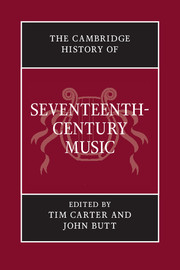Book contents
- Frontmatter
- 1 Renaissance, Mannerism, Baroque
- 2 The seventeenth-century musical ‘work’
- 3 Music in the market-place
- 4 Music in new worlds
- 5 Music and the arts
- 6 Music and the sciences
- 7 The search for musical meaning
- 8 Power and display: music in court theatre
- 9 Mask and illusion: Italian opera after 1637
- 10 The Church Triumphant: music in the liturgy
- 11 Devotion, piety and commemoration: sacred songs and oratorios
- 12 Image and eloquence: secular song
- 13 Fantasy and craft: the solo instrumentalist
- 14 Form and gesture: canzona, sonata and concerto
- Appendix I Chronology
- Appendix II Places and institutions
- Appendix III Personalia
- Index
- References
14 - Form and gesture: canzona, sonata and concerto
Published online by Cambridge University Press: 28 March 2008
- Frontmatter
- 1 Renaissance, Mannerism, Baroque
- 2 The seventeenth-century musical ‘work’
- 3 Music in the market-place
- 4 Music in new worlds
- 5 Music and the arts
- 6 Music and the sciences
- 7 The search for musical meaning
- 8 Power and display: music in court theatre
- 9 Mask and illusion: Italian opera after 1637
- 10 The Church Triumphant: music in the liturgy
- 11 Devotion, piety and commemoration: sacred songs and oratorios
- 12 Image and eloquence: secular song
- 13 Fantasy and craft: the solo instrumentalist
- 14 Form and gesture: canzona, sonata and concerto
- Appendix I Chronology
- Appendix II Places and institutions
- Appendix III Personalia
- Index
- References
Summary
On 1 January 1700, Arcangelo Corelli (1653–1713) published his Sonate a violino e violone o cimbalo, op. 5, in Rome. The collection stood as a landmark for violinist–composers of his time and well after, and further enhanced Corelli’s international fame, which had been established by four earlier collections of trio-sonatas published during the 1680s and 1690s. Together with Giuseppe Torelli (1658–1709) and Antonio Vivaldi (1678–1741), Corelli would also establish the concerto as a genre of lasting importance. Their success represents the apogee of Italianate instrumental genres of the late sixteenth and seventeenth centuries, which had spread through northern Europe to German provinces, England and even, by the 1690s, to France.
Contemporary comment reveals not just how popular such instrumental genres were to their admirers, but also how vividly expressive. In 1656 the Jesuit polymath Athanasius Kircher described hearing at an accademia a small ensemble of two violinists (Salvatore Mazzella and Michelangelo Rossi) and a theorbo player (Lelio Colista, whose compositions Kircher admired):
They played with such blending of harmony, with such unusual extractions of uncommon intervals that as a result, although I can confess that in music I have investigated outstanding things, I nevertheless do not remember that I have experienced anything similar. For while they were mixing the diatonic with the chromatic, and these with the enharmonic, it is impossible to state how much the unusual minglings of these genera stirred my mind’s emotions … While they stroked the strings in a pure manner and with a subtle drawing of the bow, they seemed among themselves to be provoking the spirits of a leaping heart. Sometimes with the somewhat sad disdain of a murmuring sound, they aroused an emotion towards something gloomy and mournful – you would say that you were attending a tragic play.
In due course from a rather sad modulation they carried me little by little from relaxed figures into rapid, intense passages full of joy and dancing with such force that they were close to overwhelming me with a kind of raving madness. From there, in alternating passages rising up into something tumultuous and full of violent ferocity, they incited the mind to battles and combats. When the attack had finally subsided into something characteristic of a rather sweet affection, they summoned heavenly devotion suitable of compassion and disdain for the world.
- Type
- Chapter
- Information
- The Cambridge History of Seventeenth-Century Music , pp. 479 - 532Publisher: Cambridge University PressPrint publication year: 2005



